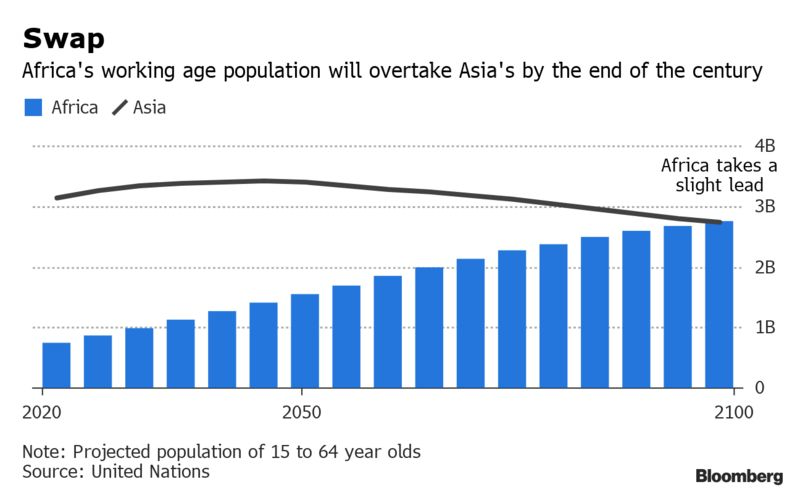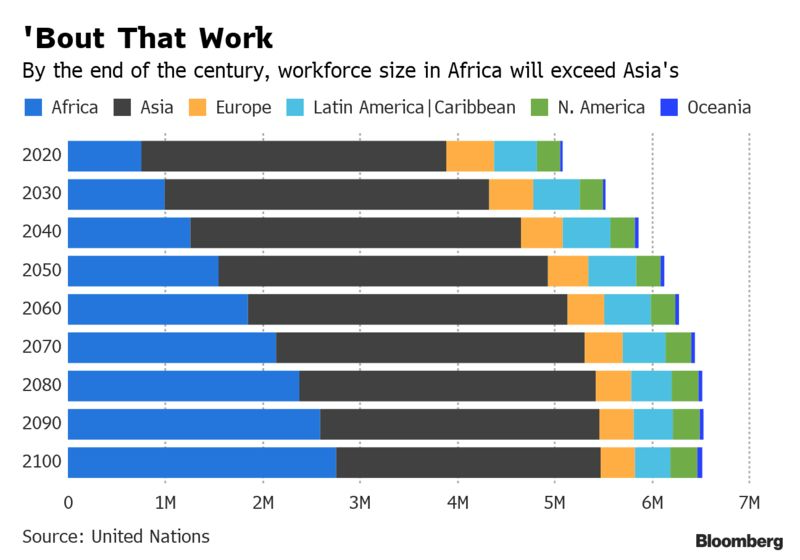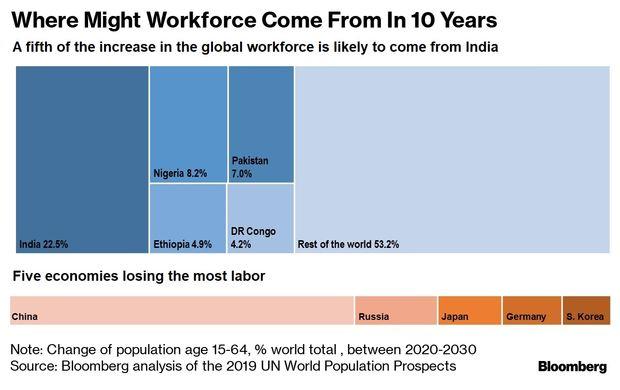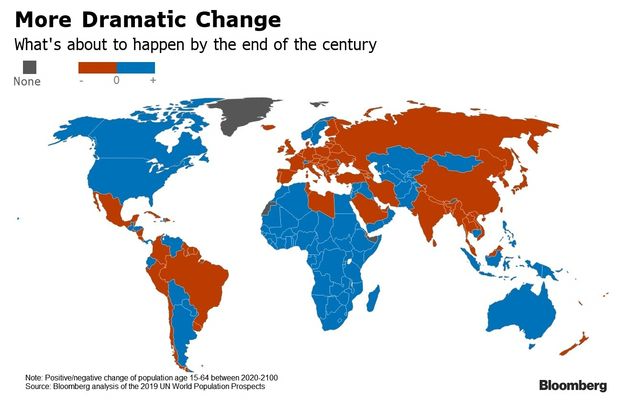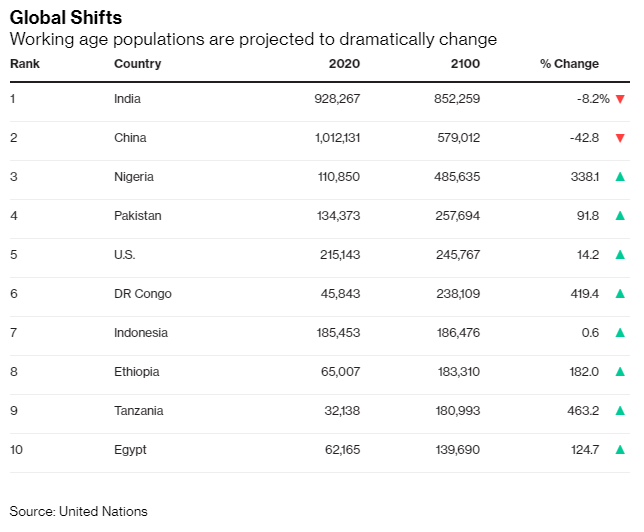As both countries struggle with demographic and economic challenges, Africa’s potential work force is set to surpass Asia’s by the end of the 21st-century, according to Bloomberg.
15 to 64 year old Africans today represent just a quarter of the size of Asia’s working age population, but the story could be different by the year 2100. Africa will then surpass Asia, as Asia will be confronted by an aging population and Africa will become flush with youth looking for employment.
However, it isn’t clear that economies on the African continent will expand enough to accommodate a robust and growing working age population. Additionally, potential employees may not have the skills that these jobs require.
Nigeria’s potential labor force should spike by almost 350%, or 375 million people, by the end of the century to more than 485 million. The IMF, however, recently noted substantial inequality in access to education by gender in between the rich and poor in Nigeria. A recent study found that a girl born into a family in the poorest 20% of society spends only about one year in school.
William Lee, chief economist at the Milken Institute said:
“As global supply chains reduce labor inputs with better technology and machines for even lower value-added production, it will be difficult for young workers in Africa to find unskilled manufacturing jobs in the future similar to those now employing Asian youth.”
The number of available employees worldwide will rise 29% to 6.5 billion from 5 billion by the end of the century. Of this, Africa’s share will rise to more than 33% around 2100 from almost 15%. The working age population of the continent will grow by 2 billion to 2.75 billion over the next 80 years and Asias is set to decline by 415 million, or 13%.
“Most people overlook the fact that the Chinese dependency ratio — the working-age to over-65 population — is deteriorating rapidly and is already showing signs of straining,” Lee continued.
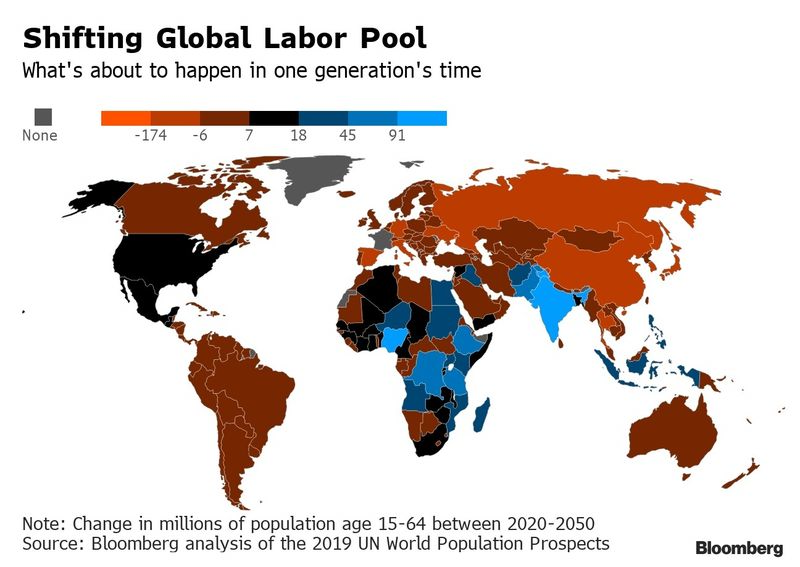
The total number of people aged 15 to 64 globally will peak at 6.5 billion around 2090. This marks an increase of 1.5 billion from today. About 80% of this gain is expected to come from low income countries and the remainder from middle income nations. High income countries will see their potential labor force shrink as birth rates remain low.
These large shifts will take place in a very short period of time. For instance, in 2020, everyone over 65 will be supported by an estimated seven workers. By 2050, this ratio will drop to about four workers per person.
These shifts will create challenges for governments in a number of countries, according to Bloomberg:
Taxation, assets prices and the use of resources will come under pressure while innovations in artificial intelligence, machine learning, engineering and computing power may cause trepidation about employment within many industries.
A recent Oxford Economics report estimates that 20 million manufacturing positions will be lost by 2030 with lower-skilled regions hit the hardest. Oxford’s econometric model found that, on average, each newly installed robot displaces 1.6 manufacturing workers. About 1.7 million factory jobs already have gone to robots since 2000, including 400,000 in Europe, 260,000 in the U.S. and 550,000 in China, the report found.
The labor force in North America and Oceana will increase by close to 38 million and 17 million, respectively, while Europe will experience a decline of 137 million or 28%. The working-age population in Latin America and the Caribbean will shrink by 15% or 66 million.
While birth rates have fallen sharply in much of the developed world, migration has enabled the population in North America to continue growing. The number of working-age men and women in the U.S. will rise 1.2% to 243 million by 2030 and then climb 14% to 278 million by 2100. The number of people in North America living longer 100 years will soar to almost 1.9 million from about 1 million today.
The two most populous nations in the world are also aging quickly.
China and India will account for 31% of total population and 39% of the world’s seniors by the year 2050. Both are also slated to see their share of the global labor force shrink.
The working age population in India is projected to peak around 2050, but 40 years later there will be fewer 15 to 64 year olds than there are today. In China, the shift will happen even quicker. The working age population of the country is already shrinking and will contract by 27.5 million by 2030. India’s working age population is expected to overtake China’s in 2027 and potential labor forces in Russia, Japan, Germany and South Korea will also be reduced due to slow birth rates and migration.
via ZeroHedge News https://ift.tt/2M3FdLz Tyler Durden
